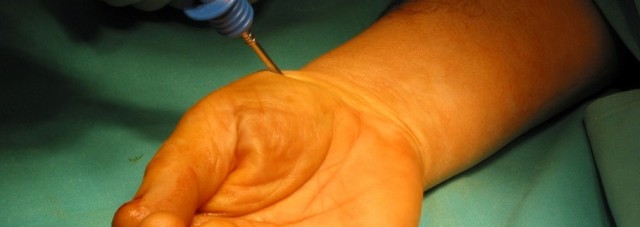The scaphoid is the part of the complex bone structure of the wrist that is injured most often. It is located in the carpus, a composition of eight bones arranged in two rows of four, whose function is to facilitate the connection between hand and forearm and, therefore, allow its movements.
The vulnerability and relevance of the scaphoid derives – precisely – from its situation as a ‘connector’ between the two rows of the carpus. Simplifying, the movements of this set of bones ‘revolve around’ the scaphoid.
We chat with Dr. Del Piñal about its most frequent causes, the associated complications and the most effective treatment to respond to this type of fracture.
Dr, why does the scaphoid break?
For the most part, scaphoid fractures have their origin in sudden falls or intense and sudden flexions of the hand. For this reason, they are common in the practice of sports prone to this type of scenario -football, basketball, handball, etc.- as well as bicycle or motorcycle accidents.
We could say that any strong activity involving impact on hand-risk may cause a fracture of the scaphoid. In fact, its incidence decreases as the age of the patients increases.

It’s always been considered a ‘treacherous’ fracture, why is it?
This kind of fracture has two fundamental problems. First, the scaphoid ‘floats’ in the joint, between the rows of the carpus, thus receives little blood supply, what makes it difficult to heal. In other words, it is the bone of the area that worst ‘glues’ after breaking.
Secondly, the ‘treacherous’ character to which you alluded, since they cause a bearable pain and relatively unimportant limitations, that sometimes the patient does not relate to a fracture.
Imagine that you are 18, 20 years old and you suffer a blow to the wrist, at that age we endure almost everything (…). The pain appears, continues for a few days, but they put a splint or an immobilization bandage -maybe even your own sports coach- and the discomfort subsides. Everything seems on track, but that’s not the case.
The undetected fracture unleashes processes in the joint that, if not addressed, will eventually lead to early arthrosis or scaphoid pseudoarthrosis.
What does this mean?
Serious problems The only solution for a scaphoid pseudoarthrosis is to operate it, since the bone has lost its intrinsic ability to heal. Thus, we have to provide what we could call ‘healing generators’, through the grafting of a bone fragment from the wrist itself.

Besides the pain itself, I usually meet patients who tell me, ‘doctor, my wrist opens up’; to what I have to answer that no, that the wrist does not ‘open’, but that there is something that does not go well behind.
In other cases, the comments are ‘my wrist creaks when moving it’ or ‘cracks’. We may be facing symptoms of a previous fracture of the scaphoid not detected.
From your point of view, Dr., what is the most appropriate treatment ?
Precisely because of the healing difficulties I told you, nowadays most scaphoid fractures are treated surgically. It is a delicate operation, which requires technical expertise, since the situation of the bone leaves little margin for error.
In a brief description, what we do is reduce the fracture in the most perfect way possible, through arthroscopy. We place the bones in the original position, to then insert a surgical screw that allows the break to weld.
This screw gives sufficient stability to the area, so that -in normal conditions- the patient can have mobility already from the day after the operation.

It is one of the great advantages of treatment with surgery, especially in patients who need to reduce recovery times due to work, sports practice, etc.
Therefore, operating not only do we get higher rates of consolidation of the scaphoid fracture, but we eliminate the need to wear plaster. We must bear in mind that the plaster could mean a recovery period of three months.

However, the message with which I would like the blog readers to keep is that we are speaking about an intervention whose success rate is 95%, if it is carried out properly.
Wrist fracture-dislocation: the case of Pedro Munitis

As we have pointed out before, scaphoid injuries have a special incidence in those who practice contact sports, especially at a professional level. Football players are included in this segment.
This was the case of former Spanish international player Pedro Munitis, who at the beginning of 2008 suffered the aggravated ‘version’ of the scaphoid lesions, that is, the fracture-dislocation of the wrist.
Munitis, who played for Racing de Santander, Real Madrid or Deportivo de La Coruña -among others- was successfully operated by Dr. Del Piñal on January 8, 2008. The injury of the Cantabrian striker, caused by a ball impact, had occurred two days before . His return to the fields took place just over a month and a half later, on February 24.
 es
es en
en fr
fr it
it ru
ru zh-hans
zh-hans
